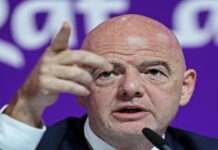North Korea and the United States each tested missiles minutes apart from one another Thursday. The two launches came at a time when tensions between the longtime foes — which had recently begun to cool down — threatened to heat up again.
In its second ballistic missile test in just five days, North Korea fired a “short-range missile” early Thursday near the western-central city of Kusong toward the Sea of Japan, known locally as the East Sea, where it landed after flying about 261 miles, according to South Korea’s military. Twenty minutes later, North Korea reportedly fired a second, similar missile that flew roughly 168 miles in the same direction.
Earlier this week, amid stalled denuclearization-for-peace talks, North Korea ended a 522-day pause on such activities with its first missle launch test since 2017.
The moves sparked condemnation from South Korea and its U.S. ally, both of whom have struggled in recent months to advance a historic peace process with North Korea. Just 11 minutes after North Korea’s first missile flew on Thursday, the U.S. launched an intercontinental ballistic missile (ICBM) test some 4,200 miles from California’s Vandenberg Air Force Base toward the Kwajalein Atoll in the Marshall Islands with little global reaction.
“By testing ballistic missiles this month, both the U.S. and North Korea risk blowing up the delicate progress that has been achieved to date through diplomacy,” Rick Wayman, deputy director of the Nuclear Age Peace Foundation, told Newsweek.
Despite the close timing—and the fact that North Korea and the U.S. launched similar missiles within days of one another last week—Air Force Global Strike Command Public Affairs said Thursday that such U.S. “launches are not a response or reaction to world events or regional tensions.”
The Pentagon has said that such tests were scheduled far ahead of time and the U.S. and Russia previously tested ICBMs within an hour and half of one another in another apparent coincidence in February.
In both cases, the U.S. fired an unarmed, yet nuclear-capable LGM-30G Minuteman III, the only operational weapon serving as the ground-based third of the nuclear triad that comprises land, air and sea assets. Just hours later, the U.S. demonstrated the naval third of its strategic power when Ohio-class ballistic missile submarine USS Rhode Island fired an unarmed Trident II D5 off the coast of Cape Canaveral, Florida.
Shortly after news broke of the North Korean launch, South Korean President Moon Jae-in called his U.S. counterpart President Donald Trump to discuss the matter, in which they agreed to “work closely” together. Both men have led one of the most peaceful periods between their allied nations and rival North Korea since the 1950s conflict that paved the way for the current hostilities on the peninsula.
Moon then addressed the national Korean Broadcasting System, warning against further launches because “if such behavior by North Korea is repeated, it could make the current dialogue and negotiation phase difficult” in some of his sternest language since peace talks began early last year. Trump offered a similar message of reserved condemnation.
“They were smaller missiles, short-range missiles. Nobody’s happy about it, but we’re taking a good look, and we’ll see,” Trump told a press briefing. “The relationship continues, but we’ll see what happens. We know they want to negotiate, they’re talking about negotiating, but I don’t think they’re ready to negotiate.”
Since Trump and Kim’s February meeting in Hanoi, Vietnam, ended abruptly without any agreement, fragile lines of communication between their countries have begun to go cold. The Pentagon’s Defense POW/MIA Accounting Agency announced Wednesday that Pyongyang had not communicated since the latest U.S.-North Korea summit, only the second of its kind in history after the two men first met in Singapore.
In the leadup to that summit, Kim pledged a pause to longer-range missile testing, though he made no formal commitments. Nor would this week’s shorter-range tests likely signal a return to the soaring tensions of 2017, when Kim showed off his country’s first ICBMs. That year, North Korea fired two Hwasong-14s, believed capable of hitting targets some 6,200 miles away, and the Hwasong-15 with an estimated range in excess of 8,000 miles—putting the entire U.S. within its sights and potentially matching that of the Minuteman III.
Other lesser-range North Korean ICBMs believed to be in development were the KN-08, also know as Hwasong-13, and a modified version known as the KN-14, according to the Center for Strategic and International Studies’ Missile Defense Project. In the intermediate-range category of missile ranging from 1,864–3,418 miles were the Hwasong-12 and BM-25 Musudan, or Hwasong-10.
While it remained to be seen whether or not North Korea possessed the technology to fit nuclear warheads on such weapons, even conventional strikes could do major damage. Kim’s armed forces possessed a variety of medium-range, short-range, submarine-launched and surface-to-air missiles that could potentially threaten South Korea and Japan, along with the tens of thousands of U.S. forces based in both countries.
Still, the U.S. was by far the world’s most powerful military and possessed an advanced arsenal of missiles. In addition to the Trident, which has a maximum range of just under 7,500 miles, the Navy wielded the long-range Tomahawk cruise missile, capable of striking more than 1,500 miles away, though it no longer served as part of the nuclear triad.

















